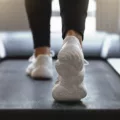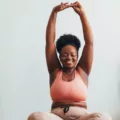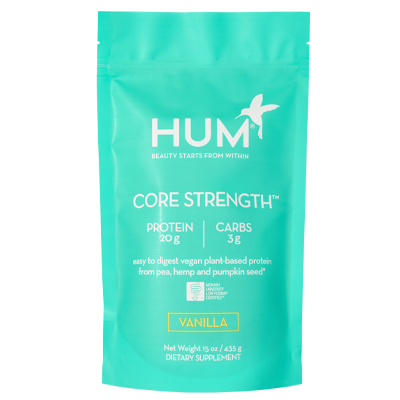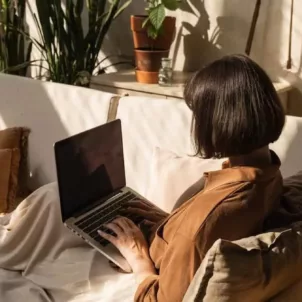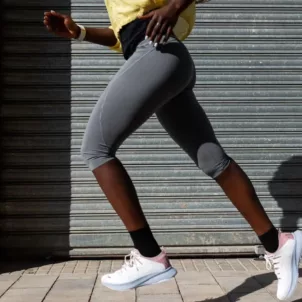Pilates Princess has been a fitness style and trend on the rise on TikTok and Instagram recently, but what are the benefits of pilates? As a personal trainer and writer/editor in the health and fitness space for the past decade, I’ve seen my fair share of fitness trends. Most notably, I started in the industry during the rise of HIIT (high-intensity interval training) in 2012. Since then, interest in HIIT continued to rise, according to Google Trends data, reaching its peak in April 2020, as we all readjusted our lives to at-home workouts. But since then, it’s been on the decline. In its place? Pilates, which last had its heyday in the early 2000s.
The sudden interest has been spurred on by influencers and instructors like Bailey Brown, Lottie Murphy, and Nicole McPherson—and the desire to take care of ourselves without being so hard on ourselves.
“I think everyone is just wanting to be gentler on our bodies after all we’ve been through,” says Jenn Seracuse, a Pilates instructor and fitness pro who teaches classes through her online platform. “Going super hard at the gym doesn’t have the same appeal as it did before. We’re all just trying to take care of our bodies and our mental health, and Pilates is such a great mind-body workout and will keep you pain-free.”
What is Pilates?
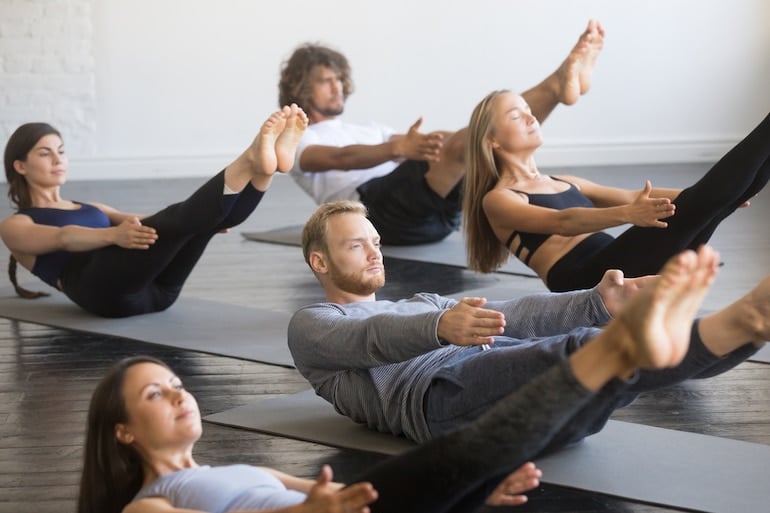
“Pilates is a low-impact form of exercise that balances strength with mobility, aligns the body, improves movement patterns, and strengthens the deeper muscles of the core and smaller stabilizing muscles throughout the entire body,” explains Sam Bell, Studio SWEAT onDemand trainer and resident Pilates expert.
Boiled down to the basics, Pilates is core strength training. “I like to describe Pilates as learning how to use your core to stabilize so you can move your limbs and spine in any way without injury,” says Seracuse. “Traditionally it was a set routine of exercises developed by Joseph Pilates on the mat and equipment like the reformer, chair, and cadillac which all have a spring resistance component to them.”
Since Pilates was founded in the 1920s, it has evolved into many different styles, explains Seracuse. These are a few you may come across:
Mat Pilates
The simplest form of Pilates, mat Pilates is done on the floor and requires only your bodyweight for resistance. Mat Pilates can be done without any equipment, but you may also find props used like the Pilates ring, Pilates ball, light weights, ankle weights, or resistance bands. Don’t be fooled by the lack of machines, though. It’s deceptively tough, says Bell.
Reformer Pilates
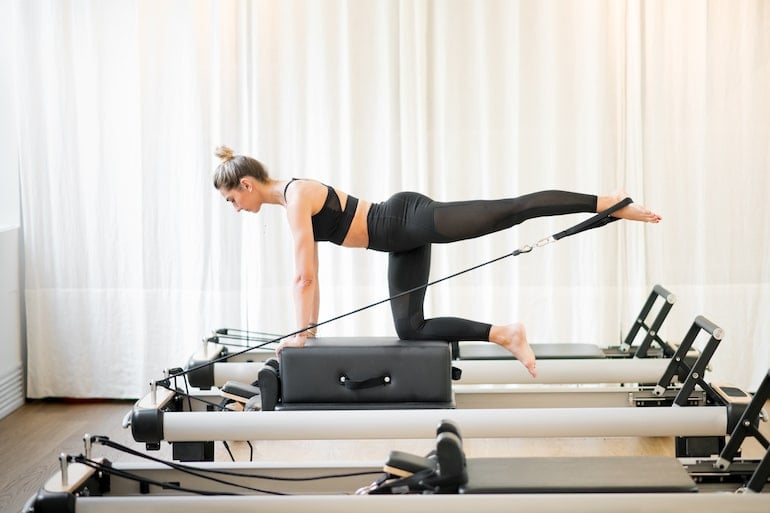
“Reformer Pilates utilizes a machine developed by Joseph Pilates that is controlled by springs that can increase or decrease the amount of support provided for any movement,” Bell states. Reformers can be helpful to isolate specific muscles and are often used for rehabilitation in addition to exercise. While Reformer Pilates used to be something only accessible if you were training with a private instructor, the rise of group reformer classes has made Pilates accessible to more people, says Seracuse. Reformers are also available for purchase online, which is why you’ve likely seen an influx of people performing Reformer Pilates at home on TikTok.
Megaformer Pilates
A souped-up version of the Reformer, called the Megaformer, has become increasingly popular for those looking for the benefits of Pilates with the added benefit of strength training. These machines, originally created by fitness pro turned entrepreneur Sebastien Lagree, guarantee a challenging workout and classes are usually fast-paced. Several studios offer classes using the original Megaformer machine or similar custom machines, including SLT, solidcore, Lagree Fitness, and BODYROK.
Hot Pilates
Similar to hot yoga, hot Pilates is simply Pilates done in a heated room. Many classes tend to be higher intensity and focus on getting your heart rate up. They may be low impacts like mat and Reformer classes or may incorporate higher impact moves, like squat jumps.
Benefits of Pilates
There are a lot of things to love about Pilates. These are just a few major benefits of Pilates.
1. It Can Boost Your Overall Fitness
“The best part about Pilates is that it makes you better at any other form of movement you want to do: running, cycling, weightlifting, etc.,” explains Seracuse. “So even just incorporating one Pilates session a week will give you major benefits.”
That’s because doing Pilates sessions consistently improves cardiorespiratory fitness, body composition, and functional fitness, a 2019 study found. Participants who exercised for 60 minutes, three times per week for 8 weeks had greater improvement in lean mass, fat mass, core strength, and trunk extensor flexibility and endurance as compared to a group who walked for the same amount of time.
While Pilates isn’t a traditional cardio exercise, the impact it can have on cardiorespiratory fitness is still measurable. A review of 10 studies found Pilates increased VO2 max, the measure of how much oxygen your body uses while exercising.
2. You’ll Work Your Whole Core
Sure, crunches definitely have their merit, but many ab workouts only work the rectus abdominis muscles. Pilates, on the other hand, works your deep core muscles, including the external and internal obliques and transverse abdominis and muscles of your back, like the erector spinae
“Strengthening your deep core muscles, connecting to your breath and really understanding how your muscles work together to stabilize and mobilize are all such powerful tools to live a long healthy life,” says Seracuse.
3. It Can Help Ease Low Back Pain
Low back pain is the most common type of pain people report to their doctor, with 25 percent of people experiencing it in the previous three months, according to the CDC. Research has found performing 60-minute Pilates sessions two to three times per week for six to eight weeks can help reduce chronic non-specific low back pain for up to three months.
4. You’ll Engage Your Pelvic Floor
The pelvic floor, a group of muscles that support your bladder, bowel, vagina, and uterus, is important for the healthy function of those organs. While kegel exercises are a common way to work these muscles, research shows Pilates can be just as effective as conventional pelvic floor exercises.
5. You Can Do it Anywhere
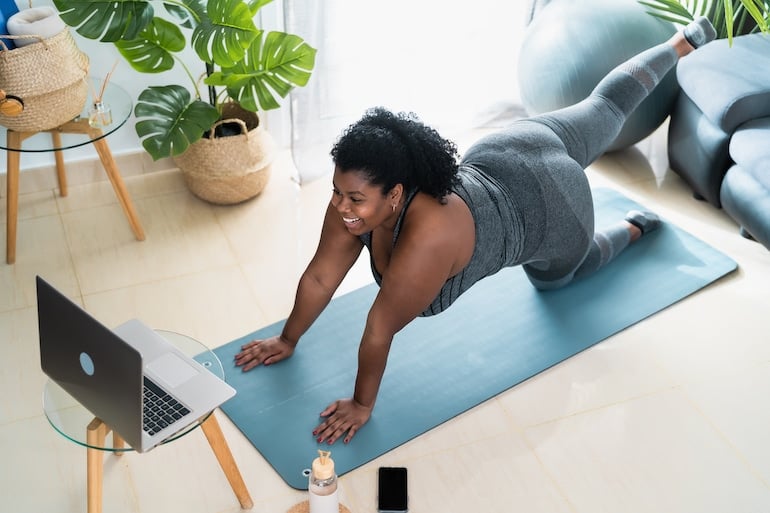
Pilates may be so popular right now because you can easily do it at home if you’re doing mat Pilates and it doesn’t require a lot of space or equipment, explains Seracuse. It’s also an ideal workout if you travel frequently or just can’t with gyms and studios right now (you’re not alone).
6. It Can Positively Impact Your Mental Health
Many forms of movement can be beneficial for your mental well-being and Pilates is no exception. People reported improved quality of life and reduced measures of depression and anxiety after eight weeks of 60-minute Pilates sessions three times a week.
“I think the most beneficial aspect of Pilates is really developing a stronger connection between your mind and body, which leads to tangible results and to keeping your body pain-free,” explains Seracuse.
7. You’ll Get an A+ in Posture
“Pilates focuses on posture which is great for anyone who works at a desk or has a driving job,” says Bell. “When we are seated for prolonged periods of time the hip flexor muscles get tight and often the upper back and neck spend a significant amount of time rounded forward. With Pilates, we focus on strengthening the opposing muscles to create a stretch for the typically tighter ones which rebalances our posture.” Improved posture can help to reduce any aches and pains and could make you feel more confident.
Is Pilates Good for Weight Loss?
So, are all the Pilates-related weight loss claims on TikTok true? Pilates can definitely help you lose weight, but it may not be the most effective method of weight loss. “You don’t burn thousands of calories in a Pilates class but you will increase your heart rate, break a sweat and improve the way every joint and muscle in your body function,” explains Bell. “Pilates is more about the way your body moves and feels.”
To lose weight, your body needs to be in a calorie deficit, which means burning more calories than you consume each day. Pilates is generally a lower-intensity workout, so you may not burn as many calories as you might by say, going for a run, making it more difficult to achieve a calorie deficit.
But there’s more to the equation. Because Pilates may help you build some lean muscle mass, which helps with fat burn, you might be able to increase your basal metabolic rate or the number of calories you burn at rest. This is especially true if resistance training wasn’t part of your routine before starting Pilates.
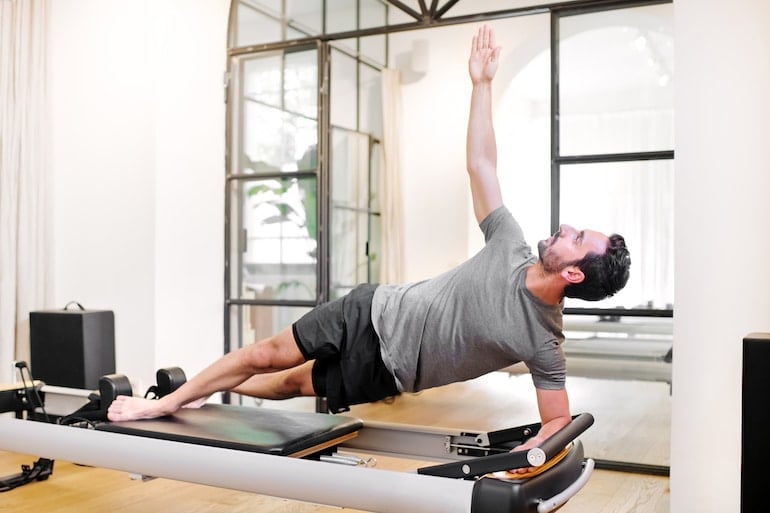
Another factor to consider—your body weight isn’t everything when it comes to aesthetics if that’s part of your desire to lose weight. Pilates activates many small accessory muscles that you may not have been working as much in other types of exercise. As you begin to use those muscles, you may notice more definition. This is part of what creates what has been dubbed by some as the “Pilates body.” But keep in mind it’s still important to work larger muscle groups, too. Not only do they support your everyday activities, but they burn more calories.
And by the way—some Pilates instructors promote the myth of “long, lean lines” as a benefit of Pilates, but there is little truth to this. “This kind of messaging is so toxic because it promotes the idea that there is a way you’re ‘supposed’ to look doing Pilates or if you do Pilates,” says Seracuse. “There is something to be said for better postural alignment, which may make you feel longer or taller just based on how you’re carrying yourself, or increased mobility and flexibility, but the ‘long lean lines’ are absolutely a myth. Pilates is truly for EVERY body!”
Pilates vs. Weightlifting
While Pilates has been skyrocketing in popularity, there’s been a staunch camp of supporters for specifically ditching weightlifting for Pilates.
Bell recommends a mix of Pilates and strength training for the best results. “Even though Pilates does build strength in the smaller and often underdeveloped muscles, we also must strengthen the larger superficial muscles,” she explains. What’s more, Seracuse says the two methods greatly complement each other, so you’ll get better at both modalities.
If you’re really looking to lose weight, specifically, weightlifting is a key component to add to your routine. Strength training will help to build muscle, which is metabolically active and can therefore increase the number of calories you burn at rest.
Pilates FAQs
1. What are the key benefits of Pilates?
Pilates improves core strength, flexibility, and posture while enhancing overall body awareness. It also supports injury prevention and stress relief through controlled, mindful movement.
2. Can Pilates help with weight loss?
Pilates can aid in weight loss by building lean muscle and increasing overall activity levels, though pairing it with cardio and a healthy diet enhances results.
3. Is Pilates good for back pain?
Yes, Pilates strengthens core muscles and improves spinal alignment, which can help alleviate and prevent back pain when practiced regularly.
4. Does Pilates build muscle?
Pilates builds long, lean muscles by emphasizing controlled movements and resistance training, which can improve strength without adding bulk.
5. How does Pilates support mental health?
The mindful nature of Pilates helps reduce stress and anxiety, enhancing mental clarity and promoting relaxation. Breathing techniques in Pilates also support emotional well-being.
6. Can beginners benefit from Pilates?
Absolutely! Pilates is adaptable to all fitness levels and provides foundational strength and mobility, making it perfect for beginners and advanced practitioners alike.
The Takeaway on the Benefits of Pilates
If you haven’t joined the Pilates bandwagon yet, there are tons of reasons to give it a try. Remember, the best type of exercise for you is ultimately the one you enjoy. No type of exercise will be ideal for every person. For the best results and to optimize your health, a routine that combines strength, cardio, mobility, and recovery is ideal.
